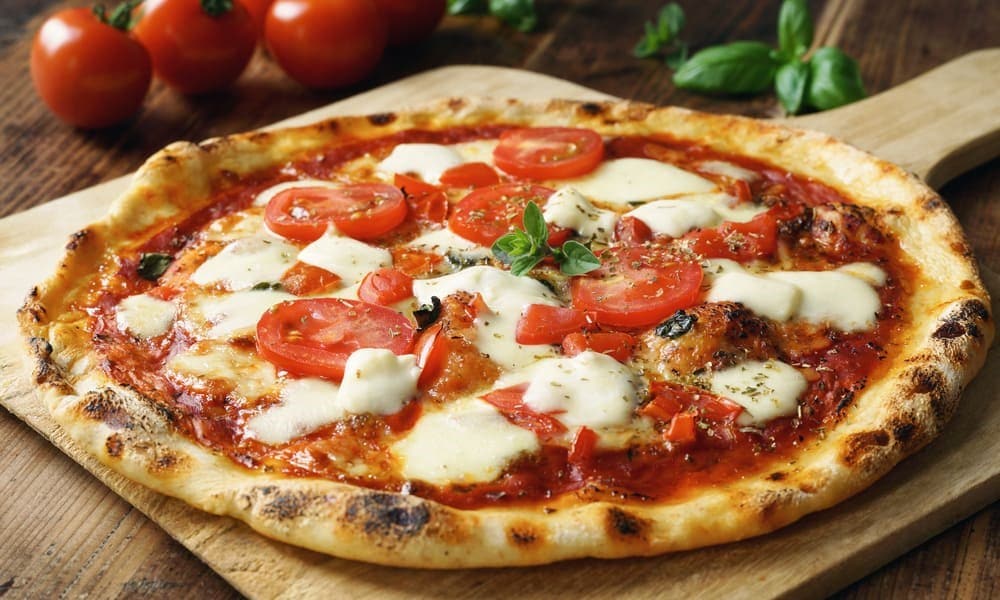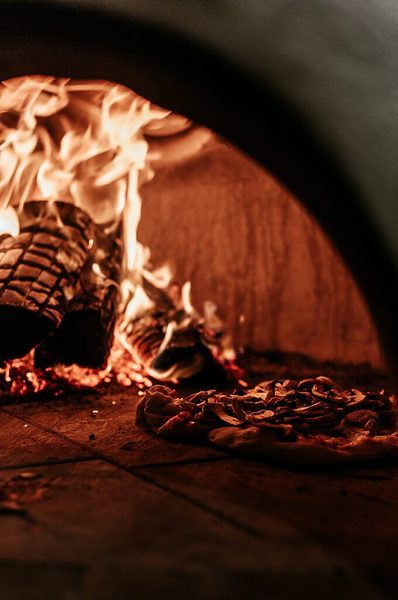New research has shown that using extra virgin olive oil when making Neapolitan pizza has a significant impact on its taste. Oh! and by the way – it makes it healthier too.

SUMMARY:
- Neapolitan pizza has been around for centuries and has a rich history
- There are specific requirements for qualifying as genuine Neapolitan pizza
- New research has shown that adding extra virgin olive oil as a topping to the iconic Neapolitan Pizza has a notable impact its quality.
CONTENTS:
- The History of Neapolitan Pizza?
- Extra Virgin Olive Oil & Neapolitan Pizza : The Study
- Conclusions On Using Extra Virgin Olive Oil in Pizza
- How Extra Virgin Olive Oil Can Make Neapolitan Pizza Healthier
- What is Neapolitan Pizza?
- Is Neapolitan Pizza Healthy?
- How to Make Neapolitan Pizza Healthier
The History of Neapolitan Pizza?
Neapolitan pizza has been around for centuries. That said, pizza was developed in Naples, Italy, during the 1700s. In fact, Neapolitan-style pizza is an evolution of Flatbread.
In Italy, flatbreads were around before the 1700s but tomatoes weren’t used as the base. Tomatoes only became a topping for pizza and flatbreads after the poor sailors of Naples began to do so. It took so long to catch on because the upper classes believed that tomatoes were poisonous.
Raffaele Esposito is credited with inventing Margherita pizza, or pizza Margherita. The pizza is named after Queen Margherita, for whom Esposito baked it.
For pizza, Neapolitan pizza has a rich history. Plus, it took several hundred years for it to catch on around the world. Neapolitan pizzas have specific requirements. Without fulfilling these requirements a pizza can’t be Neapolitan-style. Therefore, pizzerias need to become certified by the Associazione Verace Pizza Neapolitan (VPN).
Extra Virgin Olive Oil & Neapolitan Pizza : The Study
As reported in the Olive Oil Times, new research published in the journal Foods has found that adding extra virgin olive oil as a topping to the iconic Neapolitan Pizza might impact its quality. The study’s authors focused on the Neapolitan Pizza TSG (“Traditional Status Guaranteed”). This E.U.-certified status standardizes the ingredients used and the production process involved in its making.
According to the paper, different extra virgin olive oils (EVOOs) leave their own mark on the pizzas. The research assessed some of the effects on the chemical and sensory characteristics of the finished product.
“There is a risk of a general decrease in the quality of food production, including pizza, linked to the choice of adopting different and lower-cost ingredients in a global market in which ‘Made in Italy’’ foods are still highly successful and appreciated,” they wrote.
In the study, three different olive oils were tested. One was a lower-grade refined olive oil, the second was a commercial extra virgin olive oil, and the third was a high-quality monovarietal EVOO.
The three pizzas were analyzed before and after oven cooking. Free acidity, peroxide number, and spectrophotometric indices were used to assess the olive oil samples.
Extensive analyses were also conducted on all of the pizzas’ toppings. Olive oil was mixed with the other ingredients, such as tomatoes, to assess oxidation, polyphenols present and other factors.
Both EVOOs scored better than the refined olive oil. The analysis also revealed that the EVOOs’ antioxidants protect the tomatoes during cooking.
On top of that, a panel test of twelve trained judges conducted a blind sensory analysis right after cooking. The three different kinds of pizzas were tasted in random order.
The analysis has shown a higher quality taste profile for the pizza made with high-quality extra virgin olive oil, which scored significantly higher in overall flavour, tomato taste and the balance between olive oil and the other ingredients.
The scientists associated the high-quality extra virgin olive oil results with its higher nutritional and antioxidant contents, which impacted the pizza’s nutritional profile and improved its flavours.
Conclusions On Using Extra Virgin Olive Oil in Pizza
“According to the regulations of the Neapolitan Pizza TSG, extra virgin olive oil must be exclusively used as topping ingredient, together with tomato for pizza marinara-type production. As, often deliberately, other oils are replaced by pizza makers for economical and organoleptic purposes, the present study was conducted to analyze the quality of pizza depending on the oil typology used. Chemical and sensory analyses were performed on olive oils and on pizza topping mix samples after cooking to detect changes due to the applied cooking processing. The results revealed the best quality of a monovarietal extra virgin olive oil for their peculiar phenolic content related to the best oxidation stability after pizza’s cooking, expressed as bioactive amounts and lower presence of undesired volatile compounds.
Conclusions: the use of an extra virgin monovarietal extra virgin olive oil, in the topping of pizza is preferable to other oils, also extra virgin olive oil, because of its higher quality, which is reflected in greater health and pleasant characteristics from a sensorial point of view”.
Source: Effect of Oil Type Used in Neapolitan Pizza TSG Topping on …
How Extra Virgin Olive Oil Can Make Neapolitan Pizza Healthier
Neapolitan pizza has the potential to be a healthy and delicious meal, especially if you add extra virgin olive oil with its health enhancing polyphenols. While fast food versions of Neapolitan pizza are unhealthy, homemade or authentic Neapolitan pizza is healthy. Neapolitan pizza is healthy because of its authentic ingredients. A pizza with extra virgin olive oil has a taste profile that comes from ingredients like fresh basil, fresh mozzarella, and other fresh ingredients give the pizza less calories.
That said, not all Neapolitan pizza is the same.
What is Neapolitan Pizza?
True Neapolitan pizza is a type of pizza that’s made with tomatoes and fresh mozzarella cheese. The tomatoes also have to be the right tomatoes, which are San Marzano tomatoes. Without San Marzano tomatoes you can’t have authentic Neapolitan pizza.

It’s also important to note that the cheese needs to be a unique type of fresh mozzarella. The cheese needs to be Mozzarella di Bufala Campana. For a traditional Neapolitan pizza, you’ll need these authentic ingredients. While the cheese and tomatoes have to be authentic, you have more liberty with the dough. Lean doughs work well for a crispy crust, whereas dough hydration is more important for a chewy crust.
Neapolitan Pizzeria Certification (VPN)
Neapolitan pizzas have specific requirements. Without fulfilling these requirements a pizza can’t be Neapolitan-style. Therefore, pizzerias need to become certified by the Associazione Verace Pizza Neapolitan (VPN).
There is also a branch of the VPN in the United States, which certifies several restaurants. Having VPN status is sought-after because only a few hundred restaurants are authentic.
To gain this certification, pizzerias need to use the proper ingredients. What’s more, the ingredients must come from the right regions.
What are the Authentic Requirements for Neapolitan Pizza?
Neapolitan pizza requires a few unique ingredients to be authentic. The dough, cheese, and tomatoes need to be sourced from Italy. Plus, the dough needs to be kneaded by hand.
As for the contents of the dough, it must be made from Italian type 0 or 00 wheat flour. It can also be made with fresh brewer’s yeast or Neapolitan yeast. Water and salt are also typically included in authentic Neapolitan pizza dough.
Next, the Neapolitan pizza must have San Marzano tomatoes. Additionally, these tomatoes have to be grown in Italy.
For the cheese, Neapolitan-style pizza calls for fresh mozzarella. The mozzarella also has to be mozzarella di bufala or Fior di latte. Therefore, mozzarella can come from cow milk or buffalo milk.
Lastly, Neapolitan-style pizza has a few more ingredients. These include fresh basil leaves and of course, extra virgin olive oil.
How is Neapolitan Pizza Cooked?
Neapolitan pizza is typically made in a wood-fired oven. Wood-fired ovens work best because Neapolitan pizza needs to be cooked at 800°F. At 800°F, Neapolitan pizza needs to cook for about 90 seconds or two minutes.
What are the Variations of Neapolitan Pizza?
Neapolitan pizza has a few variations. Some people consider pizza Margherita to be the only authentic Neapolitan pizza but it depends on the person. According to authentic guidelines, Neapolitan pizza may include a few ingredients. Ultimately, the ingredients are what separate each variant.
Pizza Marinara
Pizza marinara includes tomatoes, salt, olive oil, water, and oregano. What makes this variant unique is that it doesn’t include fresh mozzarella cheese. Instead, all of the flavors come from the type 0 or 00 dough, tomatoes, and seasoning.
Pizza Margherita
Pizza Margherita is what comes to mind when most people think of Neapolitan pizza. It includes cow’s milk mozzarella cheese, basil leaves, tomatoes, and olive oil. Pizza Margherita is the type of pizza that was cooked for Queen Margherita of Savoy.
Pizza Margherita Extra
Pizza Margherita extra is similar to pizza Margherita. The key difference is that the mozzarella cheese comes from buffalo milk instead. Other ingredients like basil leaves, extra virgin olive oil, and tomatoes remain the same.
Pizza Bianca
Pizza Bianca is another common variant of Neapolitan pizza. However, this version doesn’t include tomato sauce. Instead, it only includes fresh mozzarella cheese, garlic, rosemary, and olive oil.
Is Neapolitan Pizza Healthy?
When focusing on how healthy or unhealthy Neapolitan pizza is, it all comes down to nutritional value. Some basic things to look for in nutritional value include calories and micronutrients. Examples include fats, proteins, and carbohydrates.
To break down the nutritional value of Neapolitan pizza it’s necessary to evaluate the calories for each ingredient.
Dough
A pizza’s dough is often what adds the most calories. Pizza dough for Neapolitan pizza is made with only a few ingredients, which makes it a lean dough. Ingredients include yeast, water, wheat, or salt. In most cases, type 00 flour is the best for Neapolitan pizza. On average, the dough in Neapolitan pizza is between 500 and 600 calories. To reduce the calories, use less dough.
The benefit of less dough is a crispy crust and you’ll feel less full. In most cases, the dough of Neapolitan pizza is often the majority of calories.
Sauce
Another ingredient is the sauce. Neapolitan pizza sauce is just tomato sauce, so the calories only come from tomatoes. Depending on the tomatoes the calories will vary.
Typically, the sauce on Neapolitan pizza is between 10 and 50 calories. A slice of pizza may have 10 calories of sauce, while the whole pizza will have about 20 to 30 calories.
Authentic Neapolitan pizza shouldn’t have any additives to the sauce.
Cheese
When it comes to calories, cheese adds a lot of calories. Calories from cheese come from fat, which contains 9 calories per gram. This is more than protein and carbohydrates, which contain 4 calories per gram. For Neapolitan pizza, there are two main types of cheese. While they’re both fresh mozzarella it’s either mozzarella di bufala or Fior di latte. Each type of mozzarella cheese has different calories. Mozzarella di bufala has about 130 calories per serving, which is 50 grams. On the other hand, frior de latte has 78 calories per slice, which is 28 grams.
Oils and Seasonings
Neapolitan pizza has a few more ingredients that add calories. Examples include extra virgin olive oil, basil, and oregano or spinach (depending on the variant). Extra virgin olive oil has around 119 calories per tablespoon and some other types of olive oil have between 100 and 120 calories.
Seasonings like salt and oregano barely add calories. Based on these ingredients, the nutritional value of Neapolitan pizza will vary.
How to Make Neapolitan Pizza Healthier
Pizza contains many ingredients and you can always alter the recipe. However, even a traditional Neapolitan pizza can still be healthy.
Don’t Order Out
Making your Neapolitan pizza is the best way to lower the calories. In many cases, restaurants add a lot of calories through olive oil and other additives. In fact, the average takeaway pizza will have an extra 100 to 200 calories. Instead of ordering out, create your Neapolitan pizza recipe. For example, you can replace high-calorie pizza dough with cauliflower dough instead.
You can also adjust the amount of cheese and olive oil to your preference.
Use a Wood-Fired Oven

Cooking methods will also help you reduce the calories of Neapolitan pizza. To reduce the calories, it’s important to use a wood-fired oven instead of a standard oven. Standard ovens take longer to cook Neapolitan pizza, which cooks away some of the nutrients. Wood-fired ovens differ because they reach temperatures of 800°F. At 800-1,000 degrees Fahrenheit, Neapolitan pizza cooks in less than two minutes. Cooking pizza faster helps the ingredients maintain their nutrients.
Be Mindful of Toppings
When making a Neapolitan pizza it’s important to avoid high-calorie toppings. Healthy pizzas don’t have too many toppings and Neapolitan pizza shouldn’t have toppings anyway.
That said, there are some healthier alternatives than toppings like pepperoni or sausage. We recommend adding toppings like spinach or other vegetables instead.
With healthier toppings, you can still experience tasty pizza without the added calories.
In Summary
Neapolitan pizza is one of the oldest and best-tasting pizzas around. Whether you make authentic Neapolitan pizza or a variant of Neapolitan-style pizza, you’re in for a treat.
While it’s not the healthiest thing to eat, it’s not unhealthy either. To make it healthy, simply add leafy greens like spinach as a topping. Take it easy on the dough and sauce. Stick to pure tomato sauce and a thin crust.
Remember, it’s not a deep-dish pizza!
